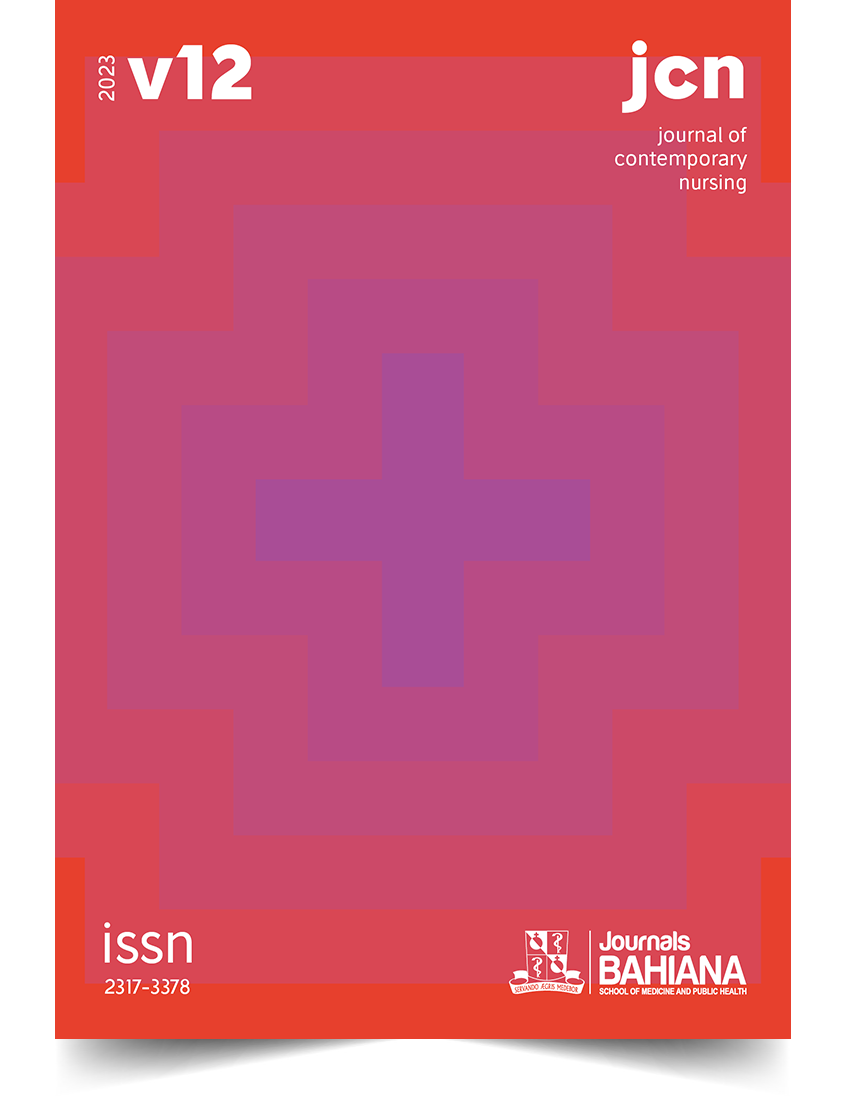Duration time and reasons for removal of peripheral venous catheter in a neonatal unit
DOI:
https://doi.org/10.17267/2317-3378rec.2023.e5122Keywords:
Hospitalized Child, Peripheral Venous Catheterization, Intensive Care Unit , Neonatal NursingAbstract
INTRODUCTION: To identify the mean length of stay of the peripheral venous catheter, describe the reasons for removing the peripheral venous catheter in newborns using a peripheral venous catheter admitted to a neonatal unit. METHOD: Quantitative research with newborns who were hospitalized in a Neonatal Unit between December 2021 and May 2022. Data were obtained from electronic medical records and the daily classification form of peripheral intravenous devices filled out in the neonatal unit, subsequently organized into spreadsheets for descriptive analysis. RESULTS: The average weight of newborns was 2312.68 grams, the main reasons for hospitalization were respiratory distress and prematurity. There were 132 punctures analyzed, the most frequent catheter permanence time was one day with 40.9%, it was also observed that 9.8% did not last 24 hours. Continuous infusion is used in 50.8% of cases, with infiltration and extravasation being the main reasons for withdrawal, while obstruction is predominant in intermittent therapies. FINAL CONSIDERATIONS: Catheters have low permanence in neonates and are removed due to the end of treatment or complications. Identifying risks allows us to develop protective barriers in peripheral intravenous therapy and contribute to the practice of daily care.
Downloads
References
(1) Nakandakari RA, Balieiro MMFG, Anacleto ASCB, Kusahara DM, Avelar AFM. Nursing practices related to peripheral intravenous catheterization in newborns and children. Rev. Soc. Bras. Enferm. Ped. 2018;18(1):29-36. https://doi.org/ 10.31508/1676-3793201800005
(2) Silva JB, Cabrera VF, Prado TP, Pimentel SM, Santos LF. Fatores associados a remoção do dispositivo de acesso vascular periférico em pacientes pediátricos. Enferm. Foco [Internet]. 2020;11(6):21-7. Available from: http://revista.cofen.gov.br/index.php/enfermagem/article/view/3297/1051
(3) Sena EMAB, Bastos MLA, Nagliate PC, Costa LC, Lopes MMCO, Lucio IML. Peripheral venipucture in prematuros: nursing care for patient safety. Rev Enferm UFPE [Internet]. 2018;12(1):1-10. Available from: https://pesquisa.bvsalud.org/portal/resource/pt/biblio-916583
(4) Rickard CM, Webster J, Wallis MC, Marsh N, McGrail MR, French V, et all. Routine versus clinically indicated replacement of peripheral intravenous catheters: a randomised controlled equivalence trial. The Lancet. 2012;380:1066-1074. https://doi.org/10.1016/S0140-6736(12)61082-4
(5) López JLG, Vilela AA, Palacio EF, Olivares CJ, Benedicto MC, Herrera PP. Indwell times, complications and costs of open vs closed safety peripheral intravenous catheters: a randomized study. J Hosp Infect. 2014;86(2):117-26. https://doi.org/10.1016/j.jhin.2013.10.008
(6) Menezes SO, Gomes MASM, Filho FL. Management of vascular access in very low birth weight newborns admitted to public neonatal intensive care units in municipality of Rio de Janeiro. Rev Pesq Saúde [Internet]. 2013;14(1):11-15. Available from: https://periodicoseletronicos.ufma.br/index.php/revistahuufma/article/view/1717
(7) Gonçalves KPO, Sabino KN, Azevedo RVM, Canhestro MR. Evaluation of maintenance care for peripheral venue catheters through indicators. REME – Rev Min Enferm [Internet]. 2019;23:e-1251. Available from: https://pesquisa.bvsalud.org/portal/resource/pt/biblio-1048761
(8) Soares F. Cateteres Periféricos: Novas Recomendações da ANVISA Garantem Segurança na Assistência. Brasília: Biblioteca virtual Cofen; 2019 [uptaded 2019 mar 13; cited 2023 sept 14]. Available from: http://biblioteca.cofen.gov.br/cateteres-perifericos-novas-recomendacoes-anvisa-garantem-seguranca-assistencia/#
(9) Rodrigues EC, Cardoso MVLML, Campos FMC, Gazelle TGA, Nobre KSS, Oliveira NR. Content Translation And Validation Of The Pediatric PIV Infiltration Scale Into Brazilian Portuguese. Rev Bras Enferm. 2020;73(4). https://doi.org/10.1590/0034-7167-2019-0300
(10) Portal de Boas Práticas em Saúde da Mulher, da Criança e do Adolescente. Principais Questões sobre Ambiência em Unidades Neonatais [Internet]. 2019. [updated 2019 feb. 21]. Available from: https://portaldeboaspraticas.iff.fiocruz.br/atencao-recem-nascido/principais-questoes-sobre-ambiencia-em-unidades-neonatais/.
(11) Ministério da Saúde (Brazil), Sociedade Beneficente Israelita Brasileira Albert Einstein. Nota técnica para organização da rede de atenção à saúde com foco na atenção primária à saúde e na atenção ambulatorial especializada - saúde da criança [Internet]. São Paulo: Anvisa; 2021. Available from: https://pesquisa.bvsalud.org/portal/resource/pt/biblio-1223374.
(12) Pereira HP, Secco IL, Arrué AM, Reichembach MT, Makuch DM. Conhecimento da equipe de enfermagem sobre cuidados com cateter central de inserção periférica em neonatos. Rev Soc Bras Enferm Ped. 2021;21(1):29-36. https://doi.org/10.31508/1676-3793202100005
(13) Bitencourt ES, Leal CN, Boostel R, Mazza VA, Felix JVC, Pedrolo E. Prevalence of phlebitis related to the use of peripheral intravenous devices in children. Cogitare Enfermagem. 2018. 23(1):e49361. http://dx.doi.org/10.5380/ce.v23i1.49361
(14) Danski MTR, Mingorance P, Johann DA, Vayego SA, Lind J. Incidência de complicações locais e fatores de risco associados ao cateter intravenoso periférico em neonatos. In: Frias AMA, Agostinho CC. Obra Prima: A Arte de Cuidar no Início da Vida. Guarujá: Editora Científica Digital; 2021. p. 282-93. Available from: https://www.editoracientifica.com.br/artigos/incidencia-de-complicacoes-locais-e-fatores-de-risco-associados-ao-cateter-intravenoso-periferico-em-neonatos
(15) Braga LM, Parreira PMSD, Arreguy-Sena C, Carlos DM, Mónico LSM, Henriques MAP. Incidence rate and the use of flushing in the prevention of obstructions of the peripheral venous catheter. Texto & Contexto – Enfermagem. 2018;27(4):e2810017. https://doi.org/10.1590/0104-07072018002810017
(16) Agência Nacional de Vigilância Sanitária (Brazil). Práticas seguras para a prevenção de incidentes envolvendo cateter intravenoso periférico em serviços de saúde [Internet]. Brasília: Anvisa; 2022. Available from: https://ameci.org.br/wp-content/uploads/2022/07/Nota-t%C3%A9cnica-preven%C3%A7%C3%A3o-les%C3%A3o-associada-a-cateter-venoso-rev-GVIMS-26-07-22-para-o-portal.pdf
(17) Silva LRFG, Dantas KL, Silva MAD, Silva LM, Silva BCLM, Ventura CMU, Santos CS. Complicações relacionadas ao Cateter Central De inserção Periférica (PICC) em UTI neonatal [final paper] [Internet]. Recife: Faculdade Pernambucana de Saúde; 2021. Available from: https://tcc.fps.edu.br/handle/fpsrepo/1125
(18) Krempser P, Caldas CP, Sena CA, Melo LD. Social representations and pediatric venus puncture stressors: contributions to nursing care. Enferm. Foco. 2020. 11(4):15-21. https://doi.org/10.21675/2357-707X.2020.v11.n4.3032
(19) Almeida TJC, Miranda JOF, Santos LM, Santana RCB, Camargo CL, Sobrinho CLN. Peripheral venous accesses in hospitalized children: a photographic study. Rev enferm UFPE [Internet]. 2016;10(2):701-7. Available from: https://periodicos.ufpe.br/revistas/revistaenfermagem/article/ viewFile/11009/12379
(20) Batista OMA, Moreira RF, Sousa AFL, Moura MEB, Andrade D, Madeira MZA. Complicações locais da terapia intravenosa periférica e fatores associados em hospital brasileiro. Revista Cubana de Enfermería [Internet]. 2018;34(3). Available from: https://revenfermeria.sld.cu/index.php/enf/article/view/1246
Downloads
Published
Issue
Section
License
Copyright (c) 2023 Gabriela Vilvert, Naiash Vanuzzi Martello, Lidiane Ferreira Schulz

This work is licensed under a Creative Commons Attribution 4.0 International License.
This work is licensed under a Creative Commons Attribution 4.0 International License.



